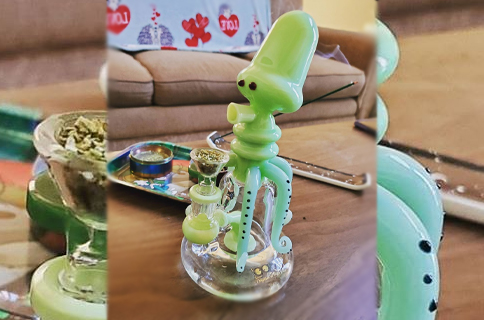
History of the bong | Fifth Ave Green House
The bong is hands down the most popular and popular smoking device in our history of cannabis use.
Bongs in Central Asia and the Silk Road.
The first written records of Bong use come from the 16th century Central Asia.
The Thai word “baung” is where we get the word “bong” today. This type of bong is specifically called a bamboo bong. These Water pipes were ubiquitous throughout Central Asia.
Image credit for photo 777bongs.com
The theory is that the use of water in bongs was introduced in China during the Ming Dynasty. The practice was spread along with tobacco through the Silk Road trade network.
A Chinese regent, Dowager Empress Cixi from the Qing Dynasty, China’s last rude dynasty, was even found buried with her three prized bongs. Some of their collections can still be seen in the Palace Museum to this day. Bongs go way back beyond that, however.
The bong was invented in Africa.
JC Dombrowski is credited with discovering the oldest bong-like invention, containing cannabis remains, found in Africa.
The first bongs, these raw smokers, were made from burning coals that were placed in a bottle buried in the ground and the cannabis was placed on the hot coals.
Credit for photo sfevergreen.com
An underground canal far from where the pipe lay underground led to a leadpipe through which the listener was smoked.
However, if we’re looking for the first hand-held Bonngs as we know them today, then we have to go to Ethiopia. Here in a cave the earliest known hand-held bongs from the time between 1100 and 1400 AD were discovered.
Many of the 11 bongs found in the cave were made from recycled pottery and animal horns.
Gold bongs
In 2015, construction workers clearing land for a power line discovered a kurgan.
The word Krugan, курга́н in Russian and Ukrainian, seems to have been taken over from the Polovtsian language and means: something that resembles a fortress, a dam or a high grave. These burial mounds were found from the Black Sea and the Caspian steppe across Central Asia to Mongolia.
Experts digging this Russian kurgan found a pair of gold bongs that are around 2,400 years old.
These items were credited to the Scythians, a violent group of nomads who ruled over the vast meadows of Eurasia. The Scythians did not build large cities or large settlements, but they left these burial mounds behind.
These bongs were part of a hoard of 7 pounds of gold and were considered part of a burial mound of some tribal chiefs. The remains of cannabis and opium it contains confirm written reports by the ancient Greek historian Herodotus that the Scythians may have used these drugs in a ritual to encourage them before going into battle.
Photo credit: https://www.ancient-code.com/
[In1945thearchaeologistMaryLeakeyfoundawaterpipeinTanzania[1945fanddieArchäologinMaryLeakeyinTansaniaeineWasserleitung
A pipe connected the bowl at the top to a lower water chamber at the bottom. The mouthpiece is placed on the curved neck of the pumpkin.
When it was discovered, experts took it for granted that Arab sailors brought marijuana and marijuana pipes to Africa in the mid-13th century. They concluded that this Marijuana pipes must have evolved from Asian pipes. But the story of this version was never meaningful.
However, the theory ignores the fact that in Asian Islamic societies, cannabis was eaten rather than smoked, and the introduction of the aqueduct did not occur until the early years of the 17th century.
All archaeological evidence also shows that Africans mainly chew and smell tobacco while they mainly smoke marijuana. Another theory is that marijuana can be adjusted by straightening the pipe and filtering it in water. This theory is also wrong because marijuana appeared earlier than tobacco in Africa.
Photo credit: cannabuddy.co.za
To put it simply: Africans invented the bong Smoking cannabis.
The name is told to us that it comes from the Thai word bong. But did the Thais get this word from Africa or did it develop independently there?

Post a comment: